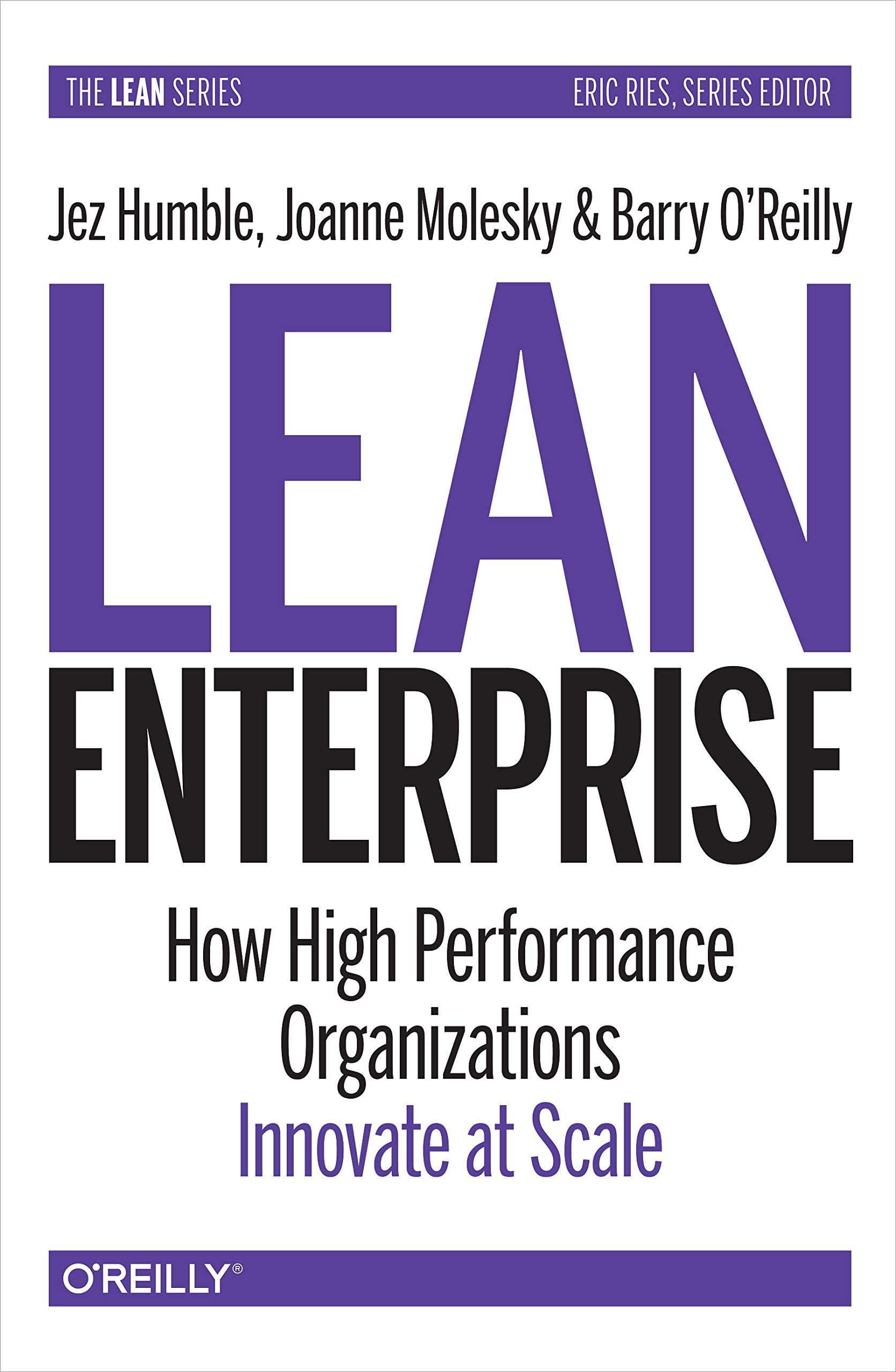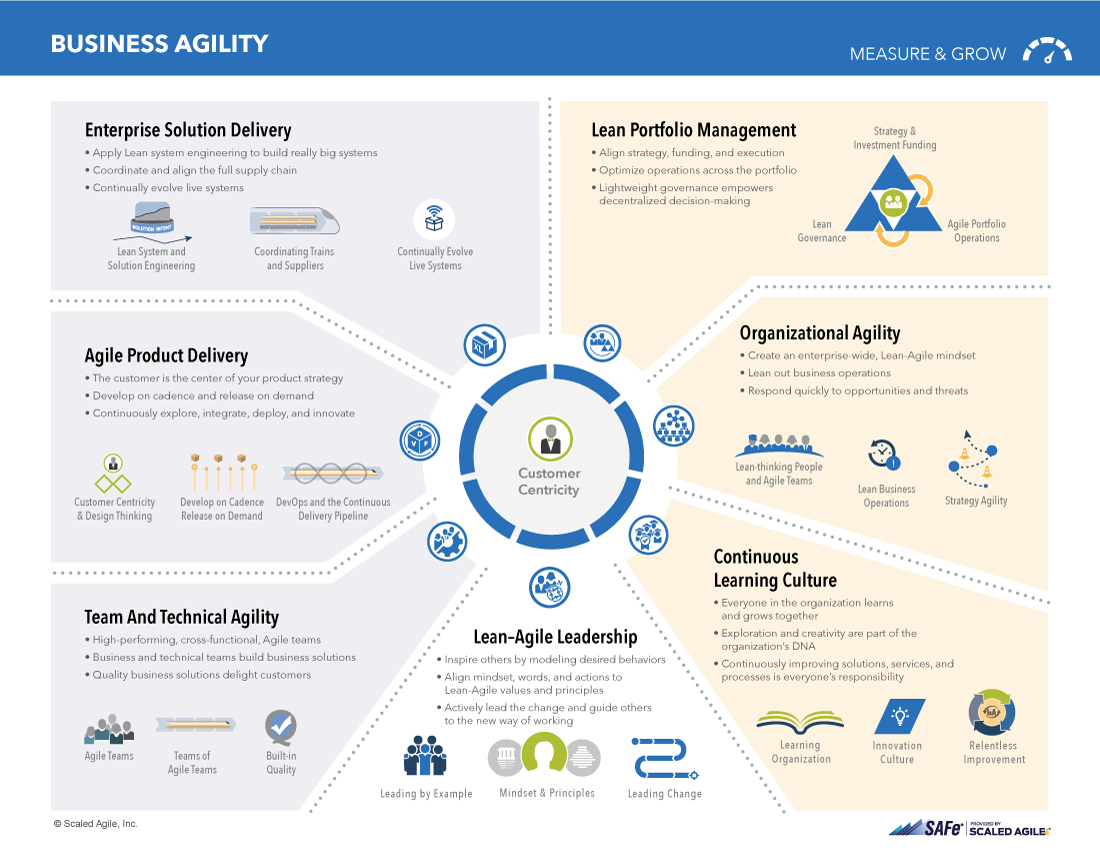Lean Enterprise Core Competencies: What It Takes to Succeed in Today's Business World
Agile practices are just the starting point - to reap the real benefits of agility, organizations need to focus on strengthening seven core competencies. Explore tangible actions organizations can take to build these critical capabilities.

In today's fast-paced business environment, companies must be agile and adaptable to thrive. The concept of a "lean enterprise" has emerged as a way for organizations to stay competitive by rapidly responding to changes in the marketplace.
This article provides an in-depth look at what it takes to build a successful lean enterprise. It outlines the seven core competencies that are essential: agile frameworks, efficient processes, customer focus, organizational agility, continuous learning, product/technology development, and business acumen.
Companies that can master these key areas will be well-positioned to meet the demands of modern business. The article explores real-world examples and provides actionable tips to help transform traditional companies into truly agile organizations.
Whether you're leading a startup or an established player, these insights will prepare you to navigate the world of lean enterprises. With an understanding of these core concepts, you can position your company for maximum flexibility, innovation and results.
Key Takeaways
- The 7 core competencies of a lean enterprise are: agile frameworks, efficient processes, customer focus, organizational agility, continuous learning, product/technology development, and business acumen.
- Mastering these skills enables companies to improve lead times, quality, customer satisfaction, and costs.
- Implementing lean practices takes time but delivers immense rewards including faster time-to-market, data-driven decisions, motivated teams, and resilience.
Seven core competencies of Lean Enterprise

Many organizations want to become more agile - able to rapidly adapt and deliver value in dynamic business environments. Adopting agile practices like Scrum or Kanban is a good start. But to really reap the benefits of agility, organizations need to focus on strengthening seven core competencies.
Foster Lean-Agile Leadership
True agile adoption requires leadership commitment at all levels. Managers and executives should champion agile values like experimentation, transparency, and a growth mindset. They should empower teams to self-organize around clear goals, rather than dictating rigid plans. Attending agile training, actively coaching teams, and promoting information sharing are tangible ways leaders can support agility. Leaders should also remove roadblocks, secure resources, and guide continuous improvement for agile teams.
Build Team and Technical Agility
Cross-functional, empowered teams are essential for business agility. Teams should have diverse skills and the authority to choose how they accomplish goals. Technical best practices like test automation, continuous integration, and pair programming boost productivity and learning. Teams should also reflect regularly on how to improve teamwork and results. Retrospectives after each iteration can uncover process tweaks to try next time.
Deliver Products and Services Iteratively
Agile product delivery focuses on frequent, iterative releases of working software. This provides faster customer feedback, reduces risk, and enables continuous improvement. Products should be measured against customer needs, with user input directly driving priorities. Collaboration between business, development, UX, and other stakeholders is key to delivering quickly. Siloes must be broken down.
Take an Iterative Approach to Enterprise Solutions
Large initiatives should still be developed iteratively, leveraging MVPs and prototypes to maximize learning. Big design up-front and fixed scope/cost contracts inhibit agility. Contracts and governance models should be reformed to encourage outcomes over outputs, fast feedback, and continuous improvement.
Deploy Lean Portfolio Management
The funding and priorities across product portfolios should align with strategic business objectives. Governance should be lean and decentralized, with decision-making authority at the team level. Initiatives should be funded in small increments based on value versus large upfront budgets. Portfolios must be dynamic, able to pivot as business needs change.
Enable Organizational Agility
Becoming an agile organization requires more than just process changes. Structures, policies, metrics, tools, and culture must all reinforce agility. For example, performance management should reward collaboration and outcomes, not individual heroics. Technology infrastructure should be flexible enough to enable rapid delivery of new product capabilities. Physical work spaces should support team collaboration.
Foster a Culture of Continuous Learning
An agile mindset means viewing setbacks as learning opportunities, not failures. Organizations should provide training, coaching, communities, and time for skills development to enable continuous learning and improvement. Learning should occur informally on the job as well as through more structured activities. Experimentation should be encouraged at all levels.
While adopting agile practices is an important starting point, organizations must focus on these seven core competencies to fully embrace an agile mindset. This will enable the rapid sensing and responding needed to thrive in dynamic business environments. What other core capabilities are needed on the agile journey?
SAFe5
The SAFe5 Framework focuses on implementing the Seven Core Competencies for Lean Enterprise. These competencies have included major changes to the five core competencies introduced to SAFe 4.6 together with two completely new competencies (organizational ability and continuous learning). These skills provide a primary lens for learning about and applying SAFe as outlined in the Overview section. These competences offer a broad range of skills to enable enterprises to improve operational performance by:
- Reducing lead time
- Improving quality
- Increasing customer satisfaction
- Reducing costs
The seven core competencies of lean enterprise are agile frameworks, efficient processes, customer focus, organizational ability, continuous learning, product and technology development, and business acumen. These competencies provide a primary lens for learning about and applying SAFe as outlined in the Overview section.
Exploring the Core Competencies of Lean Enterprises
The seven core competencies of lean enterprise are agile frameworks, efficient processes, customer focus, organizational ability, continuous learning, product and technology development, and business acumen. These competencies provide a primary lens for learning about and applying SAFe as outlined in the Overview section.
Adaptability
The first competency that we will discuss is the ability to rapidly adapt to change. In order to be successful, you need to be able to quickly adapt to changes in the market. This means that you need to be able to agilely respond to changes in customer demands, new technologies, and the competitive landscape.
Efficiency
Another important competency for lean enterprises is the ability to efficiently execute on their agile frameworks. In order to be efficient, you need to have a well-defined process for how you will execute your agile framework. This process should be designed so that it can be easily followed by all members of your team.
Safety
Finally, lean enterprises need to have a strong focus on safety. Safety is critical in today's business world, and you need to make sure that your agile frameworks are designed with safety in mind. You also need to have a robust safety plan in place so that you can quickly respond to any incidents that may occur.
Improves business outcomes
The project is based on over ten years of field experience combining four main sources: Agile development, system thinking, agile product development, and DevOps. It assists businesses with the questions listed above in order to answer the most important business or individual needs. SAFe5 helps organizations to improve business agility and business outcomes across a range of vertical markets globally.
By implementing the seven core competencies of lean enterprise, you will be able to improve your business outcomes. These competencies will help you to agilely respond to changes in the market, execute your agile framework efficiently, and maintain a focus on safety. If you are looking to improve your business outcomes, then lean enterprise is the way to go.
Scaled Agile Framework (SAFe)
The scaled agile framework is a process for agilely responding to changes in the market. It provides a framework for agilely executing your agile framework and maintaining a focus on safety. By following the scaled agile framework, you can improve your business outcomes across a range of vertical markets globally.
The scaled agile framework is important because it helps organizations to improve their business agility and business outcomes. By following the seven core competencies of lean enterprise, you can improve your agile frameworks and become more efficient. This will help you to agilely respond to changes in the market, execute your agile framework efficiently, and maintain a focus on safety.
Unlocking Lean Agile Leadership
Lean agile leadership is the ability to lead an agile organization. This means that you need to be able to agilely respond to changes in the market, execute your agile framework efficiently, and maintain a focus on safety. By implementing the seven core competencies of lean agile leadership, you can improve your business outcomes across a range of vertical markets globally.
Lean Agile Principles
There are seven lean agile leadership principles that you need to know in order to be successful in today's business world. These principles are agile response, customer focus, value-based decisions, systems thinking, empowered teams, continuous learning, and leadership at all levels. These principles will help you to agilely respond to changes in the market, make value-based decisions, and lead an agile organization.
The lean agile principles include agile response, customer focus, value-based decisions, systems thinking, empowered teams, continuous learning, and leadership at all levels.
Lean Portfolio Management
Lean portfolio management is a process for agilely managing your product portfolio. It is important for lean enterprises because it allows you to make agile decisions about which products to develop and which products to retire. This process helps you to focus on the most important products and eliminates distractions caused by less important products.
The lean portfolio management process includes five steps: envision, define, build, measure, and learn. These steps will help you to agilely manage your product portfolio and make agile decisions about which products to develop and which products to retire.
Agile teams at the key to success
Agile teams are important to lean enterprises because they allow you to agilely respond to changes in the market, make value-based decisions, and lead an agile organization.
Agile teams work by implementing agile frameworks such as Scrum or Kanban. This allows them to be efficient and responsive to changes in the market. They are also able to make value-based decisions, which helps to improve business outcomes. Finally, agile teams are led by agile leaders, who adhere to the seven lean agile leadership principles.
Business agility is crucial for the Lean Enterprise
Business agility can be achieved by implementing the seven core competencies of lean enterprise. These competencies include agile response, customer focus, value-based decisions, systems thinking, empowered teams, continuous learning, and leadership at all levels. By following these competencies, you will be able to agilely respond to changes in the market, make value-based decisions, and lead an agile organization. Organizations achieve business agility through lean agile principles.
Agile practices are merely the beginning though. In order to successfully implement agile practices, teams must fully understand the lean agile principles. You can apply lean agile principles to all facets of the organization. Lean agile principles work great in non-software areas of the business, as well as for agile product delivery. Agile product delivery is the key to agility in an evolving market. Agile methods are easy to each and the transformation typically takes 1 -2 years.
Business agility is important to lean enterprises because it allows them to agilely respond to changes in the market. This is important because it allows them to stay competitive and improve their business outcomes.
Conclusion

The lean enterprise represents the future of business. Companies that embrace agility, efficiency, customer-centricity and continuous learning will have a distinct competitive advantage.
By mastering the seven core competencies outlined here, any organization can begin its journey towards becoming a lean enterprise. This cultural shift requires buy-in and participation from all levels of the company.
With strong leadership and a willingness to transform, the rewards will be immense. Companies will be able to rapidly prototype and iterate, getting innovative products and services to market faster than ever. They will make data-driven decisions that keep them ahead of customer needs. They will build resilient systems and motivated teams that can respond quickly to external shocks.
Adopting a lean model takes time, but the long-term benefits are indisputable. Companies must be proactive to ride the waves of change, rather than being swept away by them.
There has never been a better time to incorporate these powerful concepts. Companies that act today will secure a foundation for lasting success in the modern business landscape.
Frequently Asked Questions
What is a lean enterprise?
A lean enterprise is an organization that embraces agility, efficiency, customer-centricity and continuous learning in order to rapidly adapt and deliver value in dynamic business environments.
What are the 7 core competencies of a lean enterprise?
The 7 core competencies are:
- Lean-Agile Leadership
- Team and Technical Agility
- Agile Product Delivery
- Enterprise Solution Delivery
- Lean Portfolio Management
- Organizational Agility
- Continuous Learning Culture
Why is agility important for modern businesses?
Agility is crucial because it allows companies to quickly adapt to changes in customer needs, technologies, and market conditions. Agile organizations can rapidly prototype, test, and iterate to keep pace with evolving business landscapes.
How can leadership support building a lean enterprise?
Leadership at all levels must champion agile values like experimentation, transparency and growth mindset. They should empower teams, remove roadblocks, secure resources, and guide continuous improvement.
What is lean portfolio management?
Lean portfolio management is a process for dynamically managing product portfolios based on value and strategic alignment. Funding is provided in small increments rather than large upfront budgets.
How can an organization transition to a lean enterprise model?
Becoming a lean enterprise requires adopting agile practices as well as changing structures, policies, metrics and culture to reinforce agility. It takes time but delivers immense rewards like faster delivery, data-driven decisions, and resilience.
Why is continuous learning important for lean enterprises?
A culture of continuous learning, supported through training, communities and experimentation, allows organizations to constantly improve. Learning new skills and embracing innovation is essential.
What are the lean enterprise core competencies?
achieve business agility lean agile development lean agile mindset technical agility technical agility lean agile mindset lean agile practices team and technical agility competency describe competencies of the lean competencies of the lean competencies of the lean continuous delivery pipeline continuous delivery pipeline agile portfolio operations lean governance lean portfolio management competency lean agile leadership competency enterprise solution delivery enterprise solution delivery demand business solutions enable lean agile development enterprise solution delivery competency apply lean agile principles applying lean agile principles cyber physical systems continuous learning culture competency compliance adapting governance practices continuous learning culture lean product development investment funding lean systems engineering lean systems engineering critical skills business processes business benefits lean agile leaders lean agile leaders early and continuous delivery lean budgets large and complex solutions lean agile adoption software development lean flow lean agile values business solutions cross functional agile teams streams applying lean estimating cadence modifying acquisition practices effective agile principles customer centric approach high performing agile teams solutions and lean systems solutions and lean systems agency strategy transitioning comprehensive operating system technical agility devops business solutions and lean business solutions and lean agile team and technical agility value streams. value streams lean budgeting value streams core values relentless improvement.

